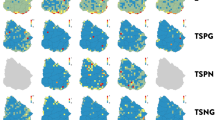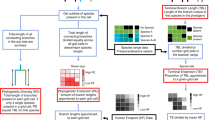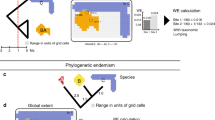Abstract
Global conservation strategies commonly assume that different taxonomic groups show congruent geographical patterns of diversity, and that the distribution of extinction-prone species in one group can therefore act as a surrogate for vulnerable species in other groups when conservation decisions are being made1,2,3,4. The validity of these assumptions remains unclear, however, because previous tests have been limited in both geographical and taxonomic extent5,6,7,8,9,10,11,12. Here we use a database on the global distribution of 19,349 living bird, mammal and amphibian species to show that, although the distribution of overall species richness is very similar among these groups, congruence in the distribution of rare and threatened species is markedly lower. Congruence is especially low among the very rarest species. Cross-taxon congruence is also highly scale dependent, being particularly low at the finer spatial resolutions relevant to real protected areas. ‘Hotspots’ of rarity and threat are therefore largely non-overlapping across groups, as are areas chosen to maximize species complementarity. Overall, our results indicate that ‘silver-bullet’ conservation strategies alone will not deliver efficient conservation solutions. Instead, priority areas for biodiversity conservation must be based on high-resolution data from multiple taxa.
This is a preview of subscription content, access via your institution
Access options
Subscribe to this journal
Receive 51 print issues and online access
$199.00 per year
only $3.90 per issue
Buy this article
- Purchase on Springer Link
- Instant access to full article PDF
Prices may be subject to local taxes which are calculated during checkout




Similar content being viewed by others
References
Stattersfield, A. J., Crosby, M. J., Long, A. J. & Wege, D. C. Endemic Bird Areas of the World: Priorities for Biodiversity Conservation (BirdLife International, Cambridge, UK, 1998)
Myers, N., Mittermeier, R. A., Mittermeier, C. G., da Fonseca, G. A. B. & Kent, J. Biodiversity hotspots for conservation priorities. Nature 403, 853–858 (2000)
Baillie, J. E. M., Hilton-Taylor, C. & Stuart, S. N. 2004 IUCN Red List of Threatened Species: A Global Species Assessment (IUCN, Glad, Switzerland, and Cambridge, UK, 2004)
Mittermeier, R. A. et al. Hotspots Revisited: Earth’s Biologically Richest and Most Endangered Terrestrial Ecoregions (Cemex, Conservation International and Agrupación Sierra Madre, Monterrey, Mexico, 2005)
Prendergast, J. R., Quinn, R. M., Lawton, J. H., Eversham, B. C. & Gibbons, D. W. Rare species, the coincidence of diversity hotspots and conservation strategies. Nature 365, 335–337 (1993)
Dobson, A. P., Rodriguez, J. P., Roberts, M. W. & Wilcove, D. S. Geographic distribution of endangered species in the United States. Science 275, 550–553 (1993)
Howard, P. C. et al. Complementarity and the use of indicator groups for reserve selection in Uganda. Nature 394, 472–475 (1998)
Lawton, J. H. et al. Biodiversity inventories, indicator taxa and effects of habitat modification in tropical forest. Nature 391, 72–76 (1998)
van Jaarsveld, A. S. et al. Biodiversity assessment and conservation strategies. Science 279, 2106–2108 (1998)
Brooks, T. et al. Toward a blueprint for conservation in Africa. Bioscience 51, 613–624 (2001)
Moore, J. L. et al. Performance of sub-Saharan vertebrates as indicator groups for identifying priority areas for conservation. Conserv. Biol. 17, 207–218 (2003)
Lamoreux, J. F. et al. Global tests of biodiversity concordance and the importance of endemism. Nature 440, 212–214 (2006)
Orme, C. D. L. et al. Global hotspots of species richness are not congruent with endemism or threat. Nature 436, 1016–1019 (2005)
Sechrest, W. W. Global Diversity, Endemism, and Conservation of Mammals. Thesis, Univ. Virginia. (2003)
Stuart, S. N. et al. Status and trends of amphibian declines and extinctions worldwide. Science 306, 1783–1786 (2004)
Clifford, P., Richardson, S. & Hemon, D. Assessing the significance of the correlation between two spatial processes. Biometrics 45, 123–134 (1989)
Olson, D. M. et al. Terrestrial ecoregions of the worlds: a new map of life on Earth. Bioscience 51, 933–938 (2001)
Pearson, D. L. & Carroll, S. S. The influence of spatial scale on cross-taxon congruence patterns and prediction accuracy of species richness. J. Biogeogr. 26, 1079–1090 (1999)
WDPA Consortium. 2005 World Database on Protected Areas 〈http://gis.tnc.org/data/IMS/WDPA_viewer/WDPA_info/index.html〉 (2005)
Rodrigues, A. S. L., Cerdeira, J. & Gaston, K. J. Flexibility, efficiency and accountability: adapting reserve selection algorithms to more complex conservation problems. Ecography 23, 565–574 (2000)
Olson, D. M. & Dinerstein, E. The Global 200: priority ecoregions for global conservation. Ann. Missouri Bot. Gard. 89, 199–224 (2002)
Orme, C. D. L. et al. Global patterns of geographic range size in birds. PLoS Biol. 4, e208 (2006)
Pressey, R. L., Humphries, C. J., Margules, C. R., Vane-Wright, R. I. & Williams, P. H. Beyond opportunism: key principles for systematic reserve selection. Trends Ecol. Evol. 8, 124–128 (1993)
Wilson, K. A., McBride, M. F., Bode, M. & Possingham, H. P. Prioritizing global conservation efforts. Nature 440, 337–340 (2006)
Brooks, T. M. et al. Global biodiversity conservation priorities. Science 313, 58–61 (2006)
Birdlife International. World Bird Database 〈http://www.birdlife.org/datazone/index.html〉 (2006)
IUCN, Conservation International & NatureServe. Global Amphibian Assessment 〈http://www.globalamphibians.org〉 (2004)
IUCN, Conservation International & NatureServe. Global Mammal Assessment 〈http://www.iucn.org/themes/ssc/biodiversity_assessments/gma/indexgma.htm〉 (2006)
Gaston, K. J. Rarity (Chapman & Hall, London, 1994)
IUCN. 2006 IUCN Red List of Threatened Species 〈http://www.iucnredlist.org〉 (2006)
Acknowledgements
We thank the field biologists who have made these data sets possible; the Global Amphibian Assessment, BirdLife International, Conservation International, IUCN, NatureServe, A. Stattersfield, S. Stuart, W. Sechrest and L. Boitani for access to data; J. Baillie, M. Balman, L. Bennun, L. Boitani, T. Brooks, M. Burgess, S. Butchart, M. Cardillo, F. Eigenbrod, S. Fritz, C. Godfray, G. Mace, S. Meiri, J. O’Dell, A. Phillimore, N. Pickup, A. Purvis, W. Sechrest, E. Smith, A. Stattersfield, S. Stuart, A. Webster and the London e-Science Centre for technical assistance, discussion or comments on the manuscript. This work was funded by the National Science Foundation and the UK Natural Environment Research Council. K.J.G. holds a Royal Society–Wolfson Research Merit Award. Author Contributions Team leaders J.L.G. and I.P.F.O. contributed equally to this work. The study was devised by R.G., C.D.L.O., J.L.G. and I.P.F.O. R.G., C.D.L.O. and S.F.J. conducted the analyses. R.G., C.D.L.O., S.F.J., G.H.T., R.G.D., T.J.D., K.E.J., V.A.O., R.S.R., P.C.R., T.-S.D., P.M.B., T.M.B., K.J.G., J.L.G. and I.P.F.O. contributed data or technical expertise. R.G., C.D.L.O., J.L.G. and I.P.F.O. wrote the initial draft of the manuscript. All authors commented on subsequent drafts.
Author information
Authors and Affiliations
Corresponding authors
Ethics declarations
Competing interests
Reprints and permissions information is available at www.nature.com/reprints. The authors declare no competing financial interests.
Supplementary information
Supplementary Notes
This file contains Supplementary Methods, Supplementary Table 1, Supplementary Figures 1–3 and additional references. (DOC 195 kb)
Rights and permissions
About this article
Cite this article
Grenyer, R., Orme, C., Jackson, S. et al. Global distribution and conservation of rare and threatened vertebrates. Nature 444, 93–96 (2006). https://doi.org/10.1038/nature05237
Received:
Accepted:
Issue Date:
DOI: https://doi.org/10.1038/nature05237
This article is cited by
-
Patterns and predictors of lichen rarity in a biodiversity hotspot
Biodiversity and Conservation (2024)
-
An updated floristic map of the world
Nature Communications (2023)
-
Amphibian species richness and endemism in tropical montane cloud forests across the Neotropics
Biodiversity and Conservation (2022)
-
Variability of diatom community composition and structure in mountain streams
Hydrobiologia (2022)
-
Conservation status of threatened land plants in China and priority sites for better conservation targets: distribution patterns and conservation gap analysis
Biodiversity and Conservation (2022)
Comments
By submitting a comment you agree to abide by our Terms and Community Guidelines. If you find something abusive or that does not comply with our terms or guidelines please flag it as inappropriate.



